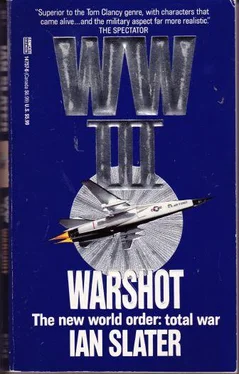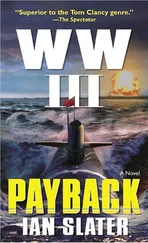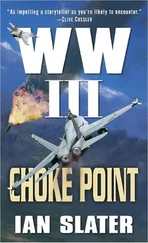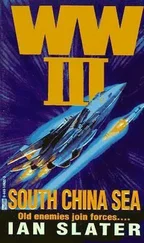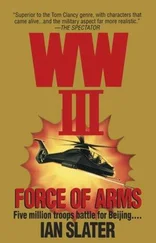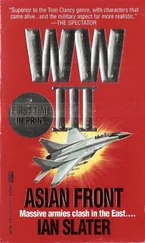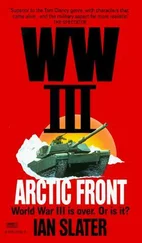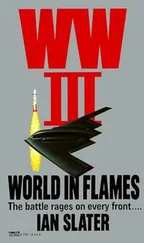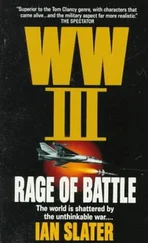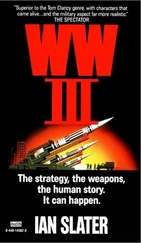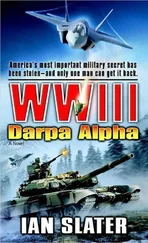Ian Slater - Warshot
Здесь есть возможность читать онлайн «Ian Slater - Warshot» весь текст электронной книги совершенно бесплатно (целиком полную версию без сокращений). В некоторых случаях можно слушать аудио, скачать через торрент в формате fb2 и присутствует краткое содержание. Год выпуска: 1992, ISBN: 1992, Издательство: Ballantine Books, Жанр: Триллер, на английском языке. Описание произведения, (предисловие) а так же отзывы посетителей доступны на портале библиотеки ЛибКат.
- Название:Warshot
- Автор:
- Издательство:Ballantine Books
- Жанр:
- Год:1992
- ISBN:0-449-14757-6
- Рейтинг книги:4 / 5. Голосов: 1
-
Избранное:Добавить в избранное
- Отзывы:
-
Ваша оценка:
- 80
- 1
- 2
- 3
- 4
- 5
Warshot: краткое содержание, описание и аннотация
Предлагаем к чтению аннотацию, описание, краткое содержание или предисловие (зависит от того, что написал сам автор книги «Warshot»). Если вы не нашли необходимую информацию о книге — напишите в комментариях, мы постараемся отыскать её.
The counterstrike: Unleash the brilliantly unorthodox American General Douglas Freeman. If this eagle can’t whip the bear and the dragon, no one can…
Warshot — читать онлайн бесплатно полную книгу (весь текст) целиком
Ниже представлен текст книги, разбитый по страницам. Система сохранения места последней прочитанной страницы, позволяет с удобством читать онлайн бесплатно книгу «Warshot», без необходимости каждый раз заново искать на чём Вы остановились. Поставьте закладку, и сможете в любой момент перейти на страницу, на которой закончили чтение.
Интервал:
Закладка:
The Aist, still rolling, now capsized, the display of its enormous black bottom looking somehow obscene, covered as it was in a froth of chocolate-mousse-colored bubbles; one of the hovercraft’s enormous push propellers, still functioning, having whipped up hydraulic fluid into a frenzied spill that soon all but obscured the rubber skirting. “God damn it, Dick!” yelled Freeman, one hand putting his helmet back on after a concussion had blown it off, the other hand pulling out his Sig Sauer nine-millimeter. “Looks like Tacoma Demolition Derby out there! Goddamn Mongols!” He fired until his magazine was empty, oblivious of shots being fired his way, slapping in a new clip, firing again into the boiling sea of blood and ice and dying Siberians amidst which Norton again didn’t feel it politic to point out that these weren’t Mongols, but Siberians. He knew what the general meant. Freeman had told Washington he would avenge the slaughter of III Corps. But even so, Freeman had given strict orders that any Sibir who put up his hands — gave any sign of surrender — was to be treated accordingly, fished out, assisted as required, and put in line to be airlifted back to Khabarovsk.
CHAPTER THIRTY-FIVE
The immediate effect of the Aist disaster meant that now Freeman’s paras could give all their attention to preparing in-depth defenses of Nizhneangarsk. Freeman opted for a “broken diamond” of razor wire, two hundred yards a side, the pattern which had been used to telling effect against the Japanese in the jungles of New Guinea in ‘42 to ‘45. The fact that there was so much snow to help hide the spring-coiled razor wire as it was unraveled to form a diamond shape helped his plan. The left top run of wire went out for fifty yards or so beyond the end of the top right run, creating die impression to anyone approaching the railhead that the top of the diamond was open — that there was a gap blown open in the perimeter defense. Either that or they’d assume there’d been a break in the wire. But once through the break, they would in fact have entered a trap, wire on their left and right, coming to a closed V. Dug in behind the bottom of the wire V would be a corresponding V of American machine guns.
To keep the approaching Siberians unloaded earlier from the Aist occupied, Freeman sent patrols a mile east of Nizhneangarsk around the lake’s edge so as to avoid the mines and to engage any Siberians who tried making their way out of the taiga to the less obstructed lake edge. In this way, the Siberian shock troops were being herded back into the forest and ultimately into the diamond of wire. In this, Freeman, as he’d anticipated, was aided by the slow going of the Siberian troops due to the mines that had been scattered by the Lynxes in the forest between Nizhneangarsk and the Aist troop drop-off point.
Personally directing the layout of the razor wire at the railhead, Freeman was pleased to notice that while they had plenty of snow with which to hide the bottom V, the blizzard itself was letting up, which meant that he could soon expect air drops to resupply and thus consolidate his position. It meant he could also now order M-1 tanks westward on the Baikal-Amur-Magistral line to Nizhneangarsk to meet any counterattack that might be contemplated by Litvinov’s northern army around Yakutsk.
The long-range effect of Freeman’s taking the railhead, quite apart from the fact that M-1 tanks were now rolling westward to Nizhneangarsk under heavy fighter protection, was that he had, as hoped, not only struck the Siberians a counterattack on their home ground, which would strike a blow at Siberian morale in general, but in doing so had created the massive diversion of vitally needed Siberian troops from the south around Baikal. This not only caused Yesov to lose the momentum of his eastward lunge, but simultaneously enabled what was left of III Corps to make the eastern side of the lake and to escape into the taiga and join the troops heading south. In all, Freeman having thrown Yesov off his stride had bought valuable time for Second Army to continue its buildup on the Chinese border.
Still, Freeman knew that a breakthrough of his in the south — any attempt to take the general offensive against the Chinese — would be impossible unless the Nanking Bridge was blown, cutting the logistical tail of the PLA, the vital line of supply for Cheng’s northern Chinese armies.
As if to underscore the tentativeness of his Nizhneangarsk victory, there was a sudden swish of air, like that of an automobile passing another at high speed on a highway, and Freeman was yanked down into oil-stained snow by Dick Norton, both of them lifted bodily by the concussion of the hundred-millimeter shell hitting Freeman’s Humvee twenty yards away. There was a soft woof, the Humvee — or rather, its buckled chassis — split and afire, the scarred snow around it a junkyard of Humvee parts, its burning engine spewing out a thick, churning column of soot-black smoke.
“What in hell—” began Freeman, but immediately hit the ground again, as did Norton and the others, a second round hitting the burning hulk with a loud whang, the chassis disintegrating, filling the air with shrapnel. For a moment Norton, deafened by the noise of the impact, couldn’t hear what the general was saying. Freeman hauled himself out of the snow, dusted himself off and pulled out the Beretta from his belt band. “God damn it! That’s the second time. No need for that!”
The general’s outrage was directed at something none of the Americans had seen during the chaotic fighting amid the Aist pileup: some of the Siberians being hauled out of the frigid waters of Lake Baikal were still fighting.
The last three Aists had floundered, but seven of their twelve PT-76 up-gunned cannon amphibious tanks had been able to roll off the Aist before the latter had been taken out by the now point-blank howitzer fire. These seven tanks were now firing their hundred-millimeter cannon even as they swam with flotation boards out toward the American positions at ten kilometers an hour, navigating their way through, and largely protected from American fire by, the very icebergs that had incapacitated their mother ships.
Perhaps Norton was the only one who fully understood Freeman’s outrage at the appearance of the amphibious PT-76s. They had been the nemesis of his armor earlier in the war. The “goddamned coffeepots,” as he called them, had been used to killing effect in North Korea, the relatively light, amphibious PT-76s, at only fourteen tons, able to move with much more maneuverability in the flooded Korean paddies than could the heavy Abrams M-1s’ sixty tons. But if the NKA had unleashed hundreds of them in the flooded rice paddies where they could move much more easily and could ford swollen streams with their flotation skirting, and the sixty-ton M-1s were often stuck and found it difficult if not impossible to negotiate on the flood plain, at least here at Nizhneangarsk the game was over for the PT-76s.
Or so it seemed.
For some inexplicable reason — perhaps because the driver of the PT-76 was concussed by the enfilade of 155mm and heavy mortar fire raining down about him, one PT-76 of the seven now approaching the Americans’ position had its lights on, and in the snow made a wonderful target, attracting fire from every kind of weapon the Americans had. Its turret suddenly imploded and it was gone in a huge bubble, along with a cheer from several of the mortar crews. Only Freeman and the paratroop commander woke up to the ploy at once and had started to yell at the mortars and antitank LAW crews to spread their fire among the others, but a quick-thinking and brave Siberian commander had succeeded nevertheless. While every “Tom, Dick, and goddamn Harry,” as Freeman later reported, “was throwing everything but his socks,” including infrared homing rounds, at that PT-76 with its lights on, the remaining six amphibians had precious seconds to find “breaching” aprons of ice that allowed them to get a grip onto the mainland at the edge of the fan-shaped sea and to fire back. In those few seconds at least three got off a hundred-millimeter round each, one of these taking out one of Freeman’s 155mm howitzer crews. There was another round, screaming overhead — so low that Freeman and Norton could feel its heat wash a split second before it hit one of the two Lynxes, which had come down to refill its “string bag” with antipersonnel mines. The explosion of the chopper was more a burst of black oil not yet alight, then a crimson flash followed by a deep, steady roar as the antipersonnel mines went off, filling the air with fragments that killed or wounded thirty-six of Freeman’s paratroopers nearby.
Читать дальшеИнтервал:
Закладка:
Похожие книги на «Warshot»
Представляем Вашему вниманию похожие книги на «Warshot» списком для выбора. Мы отобрали схожую по названию и смыслу литературу в надежде предоставить читателям больше вариантов отыскать новые, интересные, ещё непрочитанные произведения.
Обсуждение, отзывы о книге «Warshot» и просто собственные мнения читателей. Оставьте ваши комментарии, напишите, что Вы думаете о произведении, его смысле или главных героях. Укажите что конкретно понравилось, а что нет, и почему Вы так считаете.
